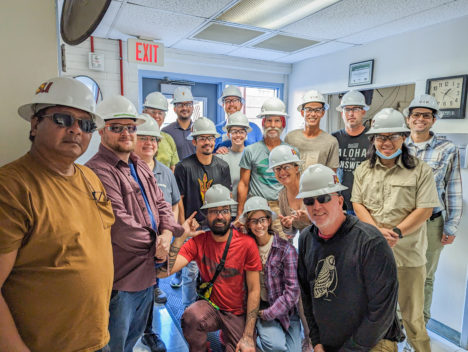Training Brings Local Energy Expertise
By Jack Kiyonaga, Reporter

Photos courtesy of Ho’ahu Energy.
Through the Molokai’s Ho’ahu Energy Cooperative, nine residents are now qualified to install solar panels and migro-grid technology.
These newly certified graduates will be essential in reaching the state’s goal of 100 percent renewable energy by the year 2045, as well as responding to Molokai’s current energy and economic needs.
The Molokai trainees attended online and Zoom classes hosted by Arizona State University, before heading off to Arizona for a week of hands-on training. The trainees were all Molokai community members who “had shown an interest in the industry,” explained Ho‘ahu Program Coordinator Liliana Napoleon.
Molokai trainees were educated in “understanding safety protocols, reading manuals…stringing solar panels together, and understanding all the components of micro-grids. The part that really stood out to all of us were the real-life applications,” said Cara Fitzpatrick, one of the nine Molokai trainees to receive their certificate.
Even a small micro-grid “could give their house lights and charge their phones and maybe even power a DC water pump and a freezer. You can really tailor a system to someone’s needs,” explained Fitzpatrick.
Specifically, this work is part of a larger project in partnership with Hawaiian Electric to bring a “community based renewable energy project to the island, in which those projects will have work for micro-grids,” said Napoleon. The benefit of these smaller solar grids is that they can better serve the individual needs of residents.
Currently in the planning phase, CBRE projects in Pala’au near the power plant and in Kualapu’u will “provide renewable energy at the community-based level, which means those who may not have the capacity or capital will still be able to reap the benefits of renewable energy,” said Napoleon.
The newly certified Molokai solar technicians will be helping build and maintain this community venture.
A community-based approach could provide more flexibility and individualization for energy needs because it is subscription based, particularly for renters or those unable to install rooftop solar on their own homes.
The Coop will assume the economic cost and risk of installing solar grids, explained Todd Yamashita, president of Ho’ahu Energy Cooperative. This model allows residents to “subscribe” to a communal renewable energy system. This will keep the money invested into solar on-island.
“Molokai has the lowest consumption of energy per capita anywhere in U.S., and yet has some of the highest utility rates,” explained Yamashita.
For Yamashita, focusing on renewables isn’t just economically viable, but demonstrates the reality of living in place like Molokai, where resources are limited.
“We strive to be independent because we have to be,” said Yamashita. “We all have to help ourselves.”
Ho’ahu Energy Cooperative has another solar certification course for 20 Molokai residents coming up in May. Partnered with Makaha Learning Center on Oahu, the subsequent course will focus on “Solar 101 plus Hawaiian Culture on Molokai,” explained Yamashita, as the Coop looks toward future jobs and opportunities in the energy sector.
While Molokai may at a disadvantage when it comes to high energy costs, the island also has an opportunity to lead in CBRE.
“If it can happen anywhere, it will happen here,” said Yamashita.











Don't have a Molokai Dispatch ID?
Sign up is easy. Sign up now
You must login to post a comment.
Lost Password